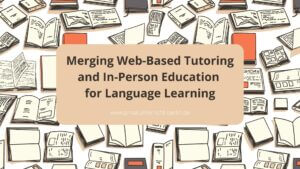Your Language Journey, Your Way: Start with a Private Tutor

Predicting The Evolution Of Online Language Education
As the world becomes increasingly globalized, the demand for language education continues to grow. Online language education has become a convenient and cost-effective alternative to traditional classroom settings.
According to recent statistics, the online language learning market is expected to reach $21.2 billion by 2027, with an estimated CAGR of 18% from 2020-2027.
With advancements in technology and increased access to the internet worldwide, online language education has become more accessible than ever before. Learners can now connect with native-speaking instructors from around the globe anytime from their homes. Additionally, many platforms offer personalized lesson plans that cater to individual learners’ needs and schedules.
However, despite these benefits, there are still challenges facing online language education providers, such as maintaining quality standards and ensuring effective student engagement.
This article seeks to analyze trends in online language education and provide insights into what the future may hold for this growing industry.
Table of Contents
Current Trends In Online Language Education
Ah, the joys of online language education. What could be better than sitting in front of a screen for hours, clicking through endless modules and videos?
Yet despite this tongue-in-cheek introduction, there is no denying that online language learning has become an increasingly popular method of study over recent years.
One trend driving this growth is gamification. By incorporating game-like elements such as points, levels, and rewards into their programs, providers can make language learning more engaging and enjoyable for students.
Another critical factor is social interaction; by offering opportunities for learners worldwide to connect through forums, interactive exercises, or even virtual classrooms, educators can create a sense of community and motivation among their students.
However, while these trends have undoubtedly contributed towards making online language education more effective and accessible than ever, it would be remiss not to acknowledge the impact of COVID-19, which has accelerated adoption rates out of necessity rather than choice.
As technology advances at breakneck speed and access becomes even more widespread globally, we expect to see further developments in how languages are taught and learned online. But what exactly does this mean for both educators and students alike? Let’s take a closer look at some of the latest advancements in technology and access that are shaping the future landscape of online language education today…
Advancements In Technology And Access
Technology has continued to revolutionize the delivery of online language education, with new tools emerging that enable students to learn more effectively.
One such technology is virtual reality (VR), which provides a highly immersive experience for learners. VR allows students to interact with digital environments and practice their language skills in real-life situations.
Another technological advancement that has transformed online learning is mobile learning. Mobile devices have enabled students to access educational materials from anywhere at any time. This flexibility makes it easier for individuals who may have yet to access traditional classrooms due to geographical or financial constraints.
With this increased accessibility, more people can participate in language courses, leading to greater diversity and cultural exchange.
- Virtual reality enhances immersion and engagement.
- Mobile learning offers increased flexibility and accessibility.
- Both technologies allow for self-paced learning.
- These advancements promote inclusivity by breaking down geographical barriers.
As we continue online language education, these technologies will play increasingly important roles in delivering personalized experiences tailored toward individual student needs. The following section will explore how personalization and flexibility are vital components of modern-day e-learning.
Personalization And Flexibility In Learning
Personalization and flexibility in learning are crucial elements of the future of online language education.
Imagine a classroom where every student receives customized attention, just like having a personal tutor who can adapt to their needs and preferences.
This is what adaptive assessments and customized curriculum offer learners in online language education.
Adaptive assessments allow for evaluation that matches each learner’s knowledge level and caters to their growth.
Customized curriculums provide personalized content that suits each student’s interests, goals, and preferred pace of learning.
These two features give students more control over their progress while keeping them motivated throughout their language-learning journey.
Learning at one’s own pace has been proven more effective than traditional teaching methods since it allows learners to focus on areas they need help without feeling rushed or left behind.
As we look towards the future of online language education, providers must also consider challenges such as competition from other platforms, maintaining quality standards, building trust with users, and addressing concerns around privacy and security.
In the next section, we will explore these potential obstacles in further detail.
Challenges For Online Language Education Providers
Retaining student engagement is one of the critical challenges facing online language education providers.
To ensure quality instruction, providers must develop effective strategies to keep students engaged and motivated.
Retaining Student Engagement
Are you curious about how to keep students engaged in online language education? As a research analyst in this field, gamification techniques are becoming increasingly popular among online language education providers.
By incorporating game-like elements into their courses, such as points systems and badges, students are incentivized to participate and compete with others actively.
Additionally, social learning opportunities can significantly improve student engagement by allowing learners to communicate with each other and form connections within the course community.
However, it is essential to note that only some gamification strategies or social learning opportunities will work for some students or situations. It is crucial for educators to continuously assess and adjust these methods based on student feedback and performance metrics.
Overall, retaining student engagement in online language education requires a combination of creative approaches tailored to individual learners’ needs.
Ensuring Quality Instruction
As an online language education research analyst, it’s essential to recognize providers’ challenges when ensuring quality instruction. One of the most critical factors in achieving this is teacher training.
Educators must be equipped with the skills and knowledge necessary to conduct practical online classes, which includes understanding how to engage students in a virtual environment. With proper support and guidance, teachers may be able to keep their students engaged or provide good feedback on assignments.
Additionally, student engagement remains a crucial aspect of quality instruction for online language education providers. Teachers must utilize various strategies, such as gamification techniques and social learning opportunities, to encourage learners’ active participation throughout the course.
By addressing these key areas, online language education providers can overcome some challenges they face when delivering high-quality instruction.
Possibilities For The Future Of Online Language Education
Moving forward, the future of online language education looks promising with the integration of gamification and social learning.
Gamification refers to incorporating game-like elements in educational settings to increase engagement and motivation among learners. Introducing competition, rewards, and challenges makes students more likely to stay motivated throughout their learning journey.
Social learning is another aspect that has gained importance in recent years as it allows individuals to learn from each other through collaboration, discussion groups, and peer feedback. This approach promotes a sense of community within an online classroom where learners can interact with each other regardless of geographic boundaries or time-zone differences.
In addition, social learning encourages learners to take ownership of their progress by sharing resources and knowledge while receiving valuable insights from peers. In conclusion, the incorporation of gamification and social learning presents immense opportunities for the future of online language education.
As technology advances rapidly, these approaches will play an increasingly significant role in shaping how we teach languages online. With increased engagement levels and interactive experiences offered by such systems, it’s clear that these methods provide a better way for learners to achieve proficiency in foreign languages than traditional teaching methods alone.
Frequently Asked Questions
What Is The Average Cost Of Online Language Education Programs?
To truly understand the market growth potential of online language education programs, it is essential to conduct a cost comparison analysis.
This will help identify trends and patterns in pricing models across different platforms and providers, which can inform decision-making for learners and educators alike.
As a research analyst in online language education, I have seen how this analysis helps stakeholders make informed choices about investments, marketing strategies, and program development.
By examining average costs, we can gain insights into what factors influence pricing – such as quality of instruction or level of customization – and how these may differ between languages or target audiences.
Ultimately, understanding the actual cost of online language education programs is crucial for anyone looking to navigate this rapidly evolving sector successfully.
How Many Languages Are Currently Available For Online Language Education?
Numerous languages are now available for online language education, with many options. The number of language options has grown exponentially in recent years, catering to the need for specialized dialects that were previously difficult to access.
From Arabic and Mandarin Chinese to Spanish and French, there are plenty of choices when learning a new language online.
As research analysts in online language education continue to monitor this trend, it’s clear that learners have more opportunities than ever before to expand their linguistic horizons through digital means.
What Are The Most Common Reasons People Choose To Learn A Language Online?
When it comes to online language education, there are many reasons people choose to learn a new language.
The benefits of learning a new language online include flexibility in scheduling, personalized instruction, and access to resources that may not be available in traditional classroom settings.
However, like any form of education, there are also challenges associated with online language learning, such as the need for more face-to-face interaction and the potential for distractions.
Understanding these factors is crucial for educators and learners as they navigate the landscape of online language education.
How Does Online Language Education Compare To Traditional Classroom Learning In Terms Of Effectiveness?
While traditional classroom learning has been the norm for decades, online language education is gaining popularity due to its flexibility and convenience. But how effective is it compared to the traditional approach?
The effectiveness comparison between these two learning styles has been debated among researchers. Some argue that online language education needs more face-to-face interaction and the personal touch of a traditional classroom. In contrast, others point out that technology enables personalized instruction and greater accessibility to resources.
As a research analyst in online language education, I find this discussion fascinating as we try to understand how learners can benefit from both approaches.
Are There Any Age Restrictions For Online Language Education Programs?
Regarding online language education programs, age restrictions and parental consent may vary depending on the platform’s policies. However, most of these programs cater to all ages and offer flexible schedules for learners who don’t have enough time during the day.
Pedagogical approaches in online language education also differ from traditional classroom learning as they often rely on multimedia tools, interactive exercises, and cultural immersion activities.
To ensure students’ progress, some platforms provide language proficiency testing before classes begin or after completing a module.
Overall, online language education offers an effective way to learn a new language without being limited by physical location or time constraints.
Conclusion
As a research analyst in online language education, it is clear that this industry has experienced significant growth in recent years.
With an average cost ranging from $100-$500 per course and over 20 languages available for study, people are turning to online language learning as a more affordable and accessible option than traditional classroom settings.
The benefits of online language education include flexibility, personalized instruction, and access to native speakers worldwide.
However, it remains essential to consider the effectiveness of these programs compared to face-to-face interaction with teachers and peers.
The evolution of technology will continue to shape the future of online language education, creating new opportunities for learners across all ages and backgrounds.
It’s up to us as analysts to keep track of trends and forecast how they’ll change the landscape over time.



